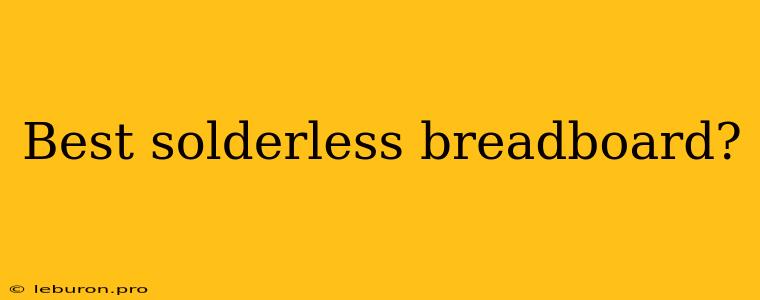Solderless breadboards are invaluable tools for hobbyists, makers, and electronics students. They provide a convenient platform for prototyping circuits without the need for soldering, allowing for quick experimentation and adjustments. With a vast array of options available, choosing the best solderless breadboard can be overwhelming. This guide will explore key factors to consider when selecting a breadboard, along with recommendations for different needs and budgets.
Understanding Solderless Breadboards
Solderless breadboards are plastic boards with rows of holes arranged in a grid pattern. Each hole is connected to a metal strip running underneath, forming a conductive path. The strips are typically arranged in groups, allowing you to connect components by simply inserting their leads into the appropriate holes.
Types of Solderless Breadboards
- Standard Breadboards: These are the most common type, featuring a rectangular grid of holes and a power bus running along the sides.
- Mini Breadboards: Smaller versions of standard breadboards, ideal for compact projects.
- Project Breadboards: Combine a standard breadboard with other components like a power supply, LEDs, and buttons, offering a more complete prototyping platform.
- Breadboard Kits: Include a breadboard along with various electronic components, making it a convenient option for beginners.
Essential Features to Consider
1. Size and Layout
The size of the best solderless breadboard depends on the complexity of your projects. For simple circuits, a mini breadboard might suffice. However, for more intricate designs, a standard breadboard or a project breadboard with a larger grid may be necessary.
2. Power Bus
The power bus is a crucial feature of a best solderless breadboard. It provides easy access to positive and negative power rails, allowing you to power your circuits without having to connect individual wires. Look for a breadboard with a dedicated power bus on both sides for added convenience.
3. Number of Rows and Columns
The number of rows and columns on the best solderless breadboard determines its capacity for accommodating components. A breadboard with more rows and columns offers greater flexibility and the ability to create more complex circuits.
4. Durability and Quality
A good best solderless breadboard should be made of durable plastic that can withstand repeated use. The metal strips should be made of high-quality material to ensure reliable connections.
5. Breadboard Compatibility
Some components, like Arduino boards, have specific breadboard-compatible headers. Ensure that the best solderless breadboard you choose is compatible with the components you intend to use.
Recommended Solderless Breadboards
1. Adafruit Best Solderless Breadboard for Beginners
The Adafruit Best Solderless Breadboard is an excellent choice for beginners and hobbyists. It offers a generous grid of holes, a power bus on both sides, and a convenient size. The durable construction and clear labeling make it a user-friendly option.
2. SparkFun Best Solderless Breadboard for Projects
The SparkFun Best Solderless Breadboard is a larger breadboard ideal for more complex projects. It features a wider grid, multiple power buses, and a built-in prototyping area for integrating additional components.
3. SunFounder Best Solderless Breadboard for Value
The SunFounder Best Solderless Breadboard is a budget-friendly option that offers good value for the price. It provides a decent grid size, a power bus, and solid construction.
4. Elecrow Best Solderless Breadboard for Arduino
The Elecrow Best Solderless Breadboard is designed specifically for Arduino projects. It features a compatible header for easy integration with Arduino boards and a dedicated power bus for power supply.
Tips for Using a Best Solderless Breadboard
- Plan your circuit layout: Before inserting components, plan the layout of your circuit on the best solderless breadboard. This helps to minimize errors and ensure a cleaner design.
- Use jumper wires: Jumper wires are essential for connecting components on a best solderless breadboard. Ensure you choose high-quality jumper wires with durable insulation.
- Check connections: After connecting components, carefully check all connections to ensure they are secure.
- Avoid overcrowding: Avoid overcrowding the best solderless breadboard with too many components. This can cause heat buildup and lead to malfunctions.
- Clean your breadboard: Regularly clean your best solderless breadboard to remove dust and debris that can affect connections.
Conclusion
Choosing the best solderless breadboard depends on your specific needs and budget. Consider factors such as size, power bus, number of rows and columns, durability, and compatibility. Whether you're a beginner or an experienced hobbyist, a best solderless breadboard is an essential tool for prototyping and experimenting with electronics. By understanding the key features and choosing the right breadboard, you can embark on exciting and successful projects with ease.
